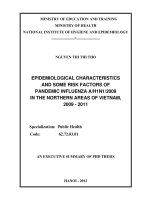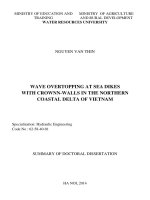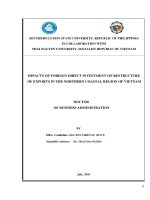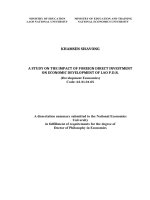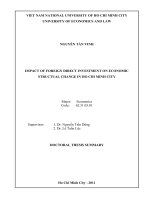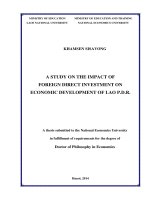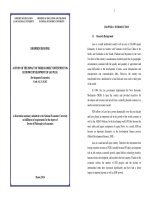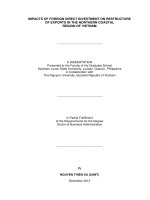Impacts of foreign direct invesment on restructure of exports in the northern coastal region of Viet Nam
Bạn đang xem bản rút gọn của tài liệu. Xem và tải ngay bản đầy đủ của tài liệu tại đây (1.55 MB, 181 trang )
IMPACTS OF FOREIGN DIRECT INVESTMENT ON RESTRUCTURE
OF EXPORTS IN THE NORTHERN COASTAL
REGION OF VIETNAM
___________________________
A DISSERTATION
Presented to the Faculty of the Graduate School
Southern Luzon State University, Lucban, Quezon, Philippines
in Collaboration with
Thai Nguyen University, Socialist Republic of Vietnam
___________________________
In Partial Fulfillment
of the Requirements for the Degree
Doctor of Business Administration
___________________________
By
NGUYEN THIEN SU (SUNT)
December 2013
i
APPROVAL SHEET
The Dissertation of
NGUYEN THIEN SU
entitled
IMPACTS OF FOREIGN DIRECT INVESTMENT ON RESTRUCTURE OF
EXPORTS IN THE NORTHERN COASTAL REGION OF VIETNAM
Submitted in Partial Fulfilment of the Requirements for the Degree
DOCTOR OF BUSINESS ADMINISTRATION
A program offered by Southern Luzon State University,
Republic of the Philippines in collaboration with
Thai Nguyen University, Socialist Republic of Vietnam
has been approved by Oral Examination Committee
WALBERTO A. MACARAAN, EdD
Expert
CONRADO L. ABRAHAM, PhD
Expert
MELCHOR MELO O. PLACINO, PhD
Expert
JOANNA PAULA A. ELLAGA, DBA
External Panel
CECILIA N. GASCON, PhD
Chairman
Endorsed by:
Recommended by:
TRAN DAI NGHIA, PhD
Adviser
APOLONIA A. ESPINOSA, PhD
Dean
Accepted in Partial Fulfilment of the Requirements for the Degree
Doctor of Business Administration
_____________________
Date
WALBERTO A. MACARAAN, EdD
Vice President for Academic Affairs
ii
CERTIFICATE OF ORIGINALITY
iii
ACKNOWLEDGMENT
One of the joys of completion is to remember all the friends and family
who have helped and supported the researcher throughout this long but
fulfilling journey to complete this research.
He would like to express his heartfelt gratitude to the Thai Nguyen
University administrators in Vietnam and Southern Luzon State University
administrators in the Philippines who created best conditions for him to
complete the course generally and fulfill the dissertation particularly.
His sincere gratitude also goes to the professors in the Council of
Examiners for Framework of the DBA namely Prof. Cecilia N. Gascon, Ph. D.,
Prof. Walberto A. Macaraan, Ph. D., Prof. Melchor Melo O. Placino, Ph. D.,
Prof. Nordelina B.Ilano, Prof. Do Anh Tai, Dr. Hoang Thi Thu, for the
encouragement and constructive feedbacks. Reviewing a thesis is a tedious
and a demanding task so that is why the researcher is very grateful for their
detailed and commendable comments.
He would like also to send his special thanks to Prof. Tran Dai Nghia
for guiding him and for giving with his careful and instructive comments
throughout the entire process writing the paper for DBA.
The researcher
would never have asked for other mentor because of the inspiration, support,
and patience that you have given to the researcher.
He will always be proud in his academic roots. In return, he aims that
he can also pass on the research values and the dreams that he has given to
him.
iv
The researcher would also like to extend his gratitude to his professors
who directly gave him useful and memorable lectures in DBA namely Prof.
Cecilia N. Gascon, Ph.D., Prof. Walberto A. Macaraan, Ed.D., Prof. Melchor
Melo O. Placino, Ph.D., Prof. Alice T. Valerio, Ph.D., Prof. Do Anh Tai, Ph.D.,
and Prof. Tran Dai Nghia, Ph.D. They provided him a very conducive and
suitable environment to study and to explore new ideas. Furthermore, they
gave him a very convenient DBA life, which was a warm and inviting place to
work.
He was very grateful to the lecturers managed by the International
Cooperation Program between Vietnam and the Philippines namely Prof.
Nguyen Tuan Anh, Prof. Dang Xuan Binh, Dr. Nguyen Thanh Hai and Ms.
Trinh Thi Hieu. He could not have a chance to join and to fulfill the course
without their cooperation.
Nguyen Thien Su
v
DEDICATION
I would like to dedicate this study to Hanoi College of Industrial
Economics, functional ministries - Ministry of Industry and Trade, and to my
colleagues for their generous support. Thank you for welcoming me as one of
your friends and for helping me to develop ideas for this study.
I would not have contemplated this road if not for my supportive
parents, my loving wife, my wonderful children, and my dear friends who
instilled within me a love of creative pursuits, and science and language, all of
which find a place in this dissertation.
NTS
vi
TABLE OF CONTENTS
PAGE
TITLE PAGE ………………………………………………………………..
i
APPROVAL SHEET ……………………………………………………….
I
CERTIFICATE OF ORIGINALITY ………………………………………..
iii
ACKNOWLEDGEMENT …………………………………………………..
iv
DEDICATION ………………………………………………………………
vi
TABLE OF CONTENTS …………………………………………………..
vii
LIST OF TABLES ………………………………………………………….
ix
LIST OF FIGURES ………………………………………………………...
xi
LIST OF APPENDICES …………………………………………………...
xii
ABSTRACT …………………………………………………………………
xiii
CHAPTER
I
II
III
INTRODUCTION ……………………………………………
1
Background of the Study …………………………………..
3
Statement of the Problem ………………………………….
5
Objectives of the Study …………………………………….
5
Hypotheses of the Study ……………………………..……
6
Significance of the Study …………………………………..
7
Scope and Limitation of the Study ………………..………
8
Definition of Terms ………………………………………….
9
REVIEW OF LITERATURE ……………………………….
11
Theoretical Framework ………………………………….…
45
Conceptual Framework ………………………………….…
64
METHODOLOGY …………………………………………..
65
Locale of the Study …………………………………………
65
Research Design ……………………………………………
69
Data Gathering Procedure …………………………………
69
Treatment of Data ……………….………………………….
70
Statistical Treatment ………………………........…….……
71
vii
IV
RESULTS AND DISCUSSIONS ………………………….
V
SUMMARY OF FINDINGS, CONCLUSIONS AND
78
RECOMMENDATIONS
131
Summary of Findings ………………………………………
131
Conclusions …………………………………………………
133
Recommendations …………………………………………
135
REFERENCES ………………………...…………………………………..
149
APPENDICES ……………………………………………………………...
154
CURRICULUM VITAE …………………………………………………….
166
viii
LIST OF TABLES
TABLE
4.1
PAGE
The Economic Indicators of the Northern Coastal Region
and the Whole Country in 2010
79
4.2
Industrial Growth of the Different Economic Sectors
86
4.3
Registered Businesses in the International Trade from
1995 to 2004
87
4.4
Contribution of Economic Sectors to Total Export Turnover
88
4.5a
The Total Export Value of the Northern Coastal Region
from 2005 to 2012
90
The Total Export Value of Provinces in the Region from
2005 to 2012
91
Export Value of the Ten Main Items with Largest
Proportion of the Total Export in the Northern Coastal
Region from 2005 to 2012
92
The Export Structure of the Northern Coastal Region from
2005 to 2012
94
Export Situation in the Northern Coastal Region from 2005
to 2012
95
Shifting Exports from Raw Materials to Processed
Products in the Northern Coastal Region from 2005 to
2012
96
PROPY Indicator of Primary Exports of the Northern
Coastal Region From 2005 to 2012
98
EXPY of the Northern Coastal Region from 2005 to 2012
(For primary goods of the Northern Coastal Region)
99
4.11
Proportion of Exports Goods with Highest PRODY Index
100
4.12
Quality of Some Exports with High Processed Content
in Export Structure of the Northern Coastal Region
101
Foreign Investment (Project Implemented before
December 2012)
104
FDI Licensed per Region from 1988 to 2012
104
4.5b
4.6
4.7
4.8a
4.8b
4.9
4.10
4.13
4.14
ix
TABLE
PAGE
4.15
FDI and Economic Growth in the Northern Coastal Region
108
4.16
Average Wages in the Northern Coastal Region from 2005
to 2012
109
4.17
Average Wages in FDI Enterprises from 2005 to 2012
110
4.18
FDI with Changes in the Proportion of Export in FDI sector
from 2005 to 2012
110
4.19
Export Value of FDI with High Level Processed Goods
111
4.20
FDI and the Northern Coastal Region Export Performance
113
4.21
FDI and the Northern Coastal Region Export Performance
by Category of Exported Goods
116
Dependent Variable Export Value by Northern Coastal
Region (Log EVt)
119
4.23
Variables Used in Model 2
121
4.24
Results of Testing Models 2
122
4.25
Results and Implications of Model
123
4.22
x
LIST OF FIGURES
FIGURE
PAGE
2.1
FDI Input Factors with Shifting Exports Structure
59
2.2
Elements of FDI Towards Impacts on Shifting Exports
Structure
64
Map showing the Survey Areas, Northern Coastal Region of
Vietnam, 2012
66
Export growth rate of the Northern Coastal Region from
2005 to 2012
91
The Export Value of the Three (3) Groups of the Northern
Coastal Region from 2005 to 2012
97
4.3
FDI Attraction in Vietnam from 1988 to 2012
102
4.4
FDI in Total Investment (%)
105
4.5
Contribution of FDI sector in GDP (%)
106
3.1
4.1
4.2
xi
LIST OF APPENDICES
APPENDIX
1
2
PAGE
FDI and the
performance
Northern
Coastal
Region
export
155
Model 1. EXPYmg = a + bFDIa=made + cEVFDI +
dGOindustrial
158
Growth rate in using FDI and producing exports
compared to the previous years
159
Proportion of using FDI and producing exports by goods
groups
160
Industrial production value by sitc of the northern coastal
region in 2005 – 2012 (Calculated on real prices)
161
Calculation of PRODY of The value of Aquatic product
exports of the Northern Coast Region in 2008
162
7
Laws Concerning FDI activities in Vietnam
163
8
Enterprises Getting Corporate Income Tax-Exemption
and Reduction
165
3
4
5
6
`
xii
ABSTRACT
Title of Research
: IMPACTS OF FOREIGN DIRECT INVESTMENT
ON RESTRUCTURE OF EXPORTS IN THE
NORTHERN COASTAL REGION OF VIETNAM
Researcher
: NGUYEN THIEN SU (SUNT)
Degree Conferred
: DOCTOR OF BUSINESS ADMINISTRATION
Name and Address
of Institution
: Southern Luzon State University, Lucban, Quezon,
Philippines and Thai Nguyen University, Socialist
Republic of Vietnam
Adviser
: Dr. Tran Dai Nghia
Year Written
: 2013
______________________________________________________________
The study was carried out to explore the impact of FDI on shifting
process of exports structure in the Northern Coastal Region of Vietnam.
Specifically, the study aimed at examining (1) influences of FDI on elements
of the economy, (2) the exports structure of the region, (3) impact of FDI on
shifting exports structure, and (4) solutions to attract FDI for shifting exports
structure in the region. The results of the study provide scientifically basic
recommendations and references for policy makers in formulating the most
appropriate policy in restructuring export sector to maximize the benefits of
exports’ sustainably.
Findings showed that there have been visible changes in term of
quantity of exports structure in the Northern Coastal Region. Also, a new
classification of the exports structure and exports restructuring besides the
traditional classifications such as SITC, VSIC was revealed from the study.
Addition, the results from the model analyses showed the significant impacts
of FDI on shifting exports structure in the Northern Coastal Region.
xiii
Specifically, the FDI made capital has a positive impact on both the
quality and quantity of the exports structure. The impact on the quality of
export structure is greater than that on the quantity. The impact of FDI on the
exports of processed and refined goods was higher than that of the raw
material goods. The FDI increases export value of private sector significantly;
while it negatively influences State Owned Enterprises; the exchange rate
also has a significant effect on the quantity of export than on the quality.
xiv
1
Chapter I
INTRODUCTION
Vietnam officially became a member of World Trade Organization
(WTO) five years ago. Since then, Vietnam’s economy has undergone many
changes and a lot of economic development. There are strategies that have
been effective to solve problems as a key point after integrating into
international economic arena, which is how to make gains more than
"losses." The loss of revenue is due to tariff cuts under WTO integration
commitments that must be offset by revenues earned from exporting goods,
products, and services. The economy of Vietnam has made many progresses
as export has increased relative stability. However, the economy still faces
serious problems including high inflation rate and increase in trade
deficit. According to the trade balance data, the growth rate of import has
always been higher than that of export since 2006. While the statistics from
the General Statistics Office showed that trade deficit was US $5.07 billion
and US $14.2 billion in 2006 and in 2007 respectively; import-export balance
continued to be negative at US $12.9 billion in 2009, US $12.4 billion, and US
$12.71 billion in 2011. Particularly, in the first quarter of 2012, the trade deficit
was over US $251 million, equal to 1% of the total export value. In which, the
whole domestic sector was in deficit of US $2.75billion whereas foreign
investment sector was in surplus of $2.5billion. According to World Trade
Organization in 2010, Vietnam became the largest importer in the Association
of Southeast Asian countries (ASEAN) for about 1.5 times. It equaled to
imports of ASEAN countries combined. Therefore, trade surplus target after
joining WTO of Vietnam has not been reached.
2
Upon joining WTO, Vietnam aims to create economic growth in a
sustainable way, to solve problems mentioned above and to meet the goals
set particularly the global economic integration. In general, Vietnam has taken
many measures to reduce trade deficit and to accelerate the pace by doing it
in the most radical measures and to improve the competitiveness of export
goods. However, in recent years, the export value of Vietnam has been very
low; one of the reasons is the structure of Vietnam's trade. Exports were
increased mostly in quantity while the export quality had not been improved,
and heavily tilted towards commodities of agriculture, forestry, fisheries, crude
oil, coal, and other low-value added processing commodities. At present, the
export value of crude oil and low-value added goods makes up to over 60% of
total export value. Industries have high percentage of outsourcing, especially
apparel and footwear. Heavy industrial goods account for 16% and they are
mainly minerals, machinery and high technology products that make up only
for 2% and 8.3 % respectively.
Based from the economists’ research, it was stated that “together with
promoting export quantity, the most important thing that every country would
like to have is to form an approptiate export structure consisting of high value
added goods with high technological content and a greater proportion in the
exports basket”. In addition, it was also discussed that “ The reason to focus
on improving export structure towards raising the quality of export structure is
that it can affect the economic growth of the country by the amount of
exports”. In other words, the increasing level of the improvement of export
products can increase economic growth. In addition, according to Kassicieh
3
and Suleiman (2002), “if a country has the quality of exports structure with
high technological content products making up a large proportion in the
basket of exported products, it will reduce risks from fluctuations in the global
trade”. Moreover, revenues generated from exports will increase and be
sustained, which is the most efficient condition and the appropriate target to
where the export should be directed to.
Other countries that are participating in the international trade have
always tried to make positive changed in the structure of their exports in order
to gain advantage in their export. So Vietnam’s exports are facing a threshold
production of traditional export products and a great threat of losing
comparative advantage in exports. Therefore, Vietnam will face great
difficulties in the future if it does not improve significantly in its exports
quality. This is one of the biggest problems in the reform strategy of exports of
Vietnam.
Background of the Study
The Northern Coastal Region of Vietnam includes five (5) provinces,
i.e., Quang Ninh, Hai Phong, Thai Binh, Nam Dinh, and Ninh Binh. According
to Decision No. 865/QĐ-TTg of the Prime Minister of Vietnam in 2008, the
Northern Coastal Region was oriented to become an important economic
region of the nation. The goal was to take all of its potentials and advantages
for the development of the region to contribute and to play a major role in
socio-economic development of Vietnam.
Furthermore, the Northern Coastal Region is one of the nine (9)
economic regions of Vietnam. Its economic contributions do not equal the
4
potentials and advantages of the region because its export situation is the
same in the entire country. The export structure is retrograde, poor in quality
and facing pressures from the international economic integration.
Hence, the issue of improving the export structure has become
essential not only to the region, but also for the entire economic development
of the country. It only indicates that the shifting exports particularly of the
Northern Coastal Region and generally of Vietnam is an indispensable
requirement. It is also necessary if they want to achieve the desired target;
they have to have an appropriate and firm control to promote the said
strategy.
In recent years, foreign direct investment has played an increasingly
vital role in the economic development of Vietnam especially on its export
activities. Recently, foreign direct investment has always taken "engine role"
in creating value that made up more than 40% of the total export value of the
country. Also, it has played essential role in promoting export of Vietnam as
well as the Northern Coastal Region". In addition, the foreign direct
investment with advantages of technology, capital investment, production
experiences, marketing skills, etc.., confers a great influence in improving the
quality of exported goods. Aside from that it also meets the requirements of
export restructure.
The study of the impacts of foreign direct investment on restructuring
export sector in the Northern Coastal Region is expected to have significant
contribution theoretically and practically. The results of this study would
provide scientific basic recommendations and references for policy makers in
forming the best policy in restructuring export sector to maximize benefits of
5
exports sustainably. This study was conceptualized because of the stated
reasons on the previous discussions. So, this study was focused on “Impacts
of Foreign Direct Investment on restructure of exports in the Northern
Coastal Region of Vietnam”.
Statement of the Problem
Generally, this study aimed to find out the impacts of foreign direct
investment on shifting exports structure in the Northern Coastal Region of
Vietnam.
Specifically, this study sought to answer the following questions:
1. How has foreign direct investment affected the elements of the
economy?
2. What are the quantitative changes present in the export structure?
3. How foreign direct investment has been affecting the shift of export
structure in the Northern Coastal Region of Vietnam?
4. What are the solutions to attract foreign direct investment on shifting
export structure of the Northern Coastal Region of Vietnam?
Objectives of the Study
General objectives:
To analyze the practical impacts of foreign direct investment and to find
out how the implementation of foreign direct investment can influence the
quantitative and qualitative restructure of exports in the Northern Coastal
Region of Vietnam.
6
Specific objectives:
1. To review the impacts of foreign direct investment on restructure of
exports and other related matters
2. To analyze quantitative indicators those are reflecting the quality of
export structure.
3. To use the models to test the impacts of foreign direct investment on
shifting exports structure in the Northern Coastal Region of Vietnam
4. To provide a set of policy recommendations and proposed solutions in
order to attract and to make effective use of foreign direct investment to
promote the exports restructuring towards the improvement of the
quality and quantity of exports in the Northern Coast region.
Hypotheses of the study
The following hypotheses were tested in the study:
Hypothesis 1: The foreign direct investment promoted shifting exports
structure in the Northern Coastal Region both quantitatively and qualitatively.
Hypothesis 2: The foreign direct investment would significantly
influence export values of private sector and public sector differently.
Hypothesis 3:
The foreign direct investment made for raw
commodities and processed food increased the value of the exports in both
processed products and raw material exported products.
Hypothesis 4: Export value of The Foreign direct investment sector
has increased the quality of export products in the Northern Coastal region.
7
Hypothesis 5: The value of industrial productions from foreign direct
investment sector could boost the impact on the complexity of export goods.
Significance of the Study
This study has the following significance:
The results of this study can be used as a scientific basis for assessing
the role of foreign direct investment in shifting the region's export structure.
The classifications are significant for the study as well as the
consideration and review of the quality of exports structure (the export quality
of each group of items, each item in order to have timely evaluation of shifting
process) and export adjustments which are very necessary to achieve the
objectives.
The implications of analyzing the role of the foreign direct investment
to shift export structure in Northern Coastal Region can be utilized as a basic
reference for further research with relevant issues in other regions in Vietnam
This research can help policy makers and provincial authorities in
making economic policies both in provincial level and in national level with
directions, policies, and specific measures to improve the export structure of
the country and to achieve the objectives of sustainable export as well as
growth and economic development in the context of international integration.
The theoretical analysis of this study will open the awareness of those
people, who are engaged in this industry, about the status of export activities,
the attraction and use of foreign direct investment, and the assessment of the
impacts of foreign direct investment on shifting exports structure. Also, this will
8
give them idea about how they can to accelerate the process of restructuring
in terms of export quantity, and to improve the quality of export structure.
The result of the study gives specific and practical application of export
management and use of foreign direct investment.
Scope and Limitations of the Study
This study was focused on impacts of foreign direct investment on
restructure of exports in the Northern Coastal Region of Vietnam. The five (5)
provinces in the Northern Coastal Region were Quang Ninh, Hai Phong, Thai
Binh, Nam Dinh, and Ninh Binh which served as locale of the study.
The scope of this research was to analyze the structure of tangible
exports. Thus, the author focused on studying elements such as the capital
performance by foreign parties, export value of the foreign direct investment
sector and value of industrial production of the foreign direct investment
sector.
The researcher did not include in the study the data of importing
intermediate goods for the production of exports of foreign direct investment
enterprises in North Coast region to assess the impact of these factors on
improving the quality of exported goods. The foreign direct investment data
made by foreign companies for each commodity and commodity group were
incomplete and non-systematic so the researcher could not calculate and
build the test mode of performing foreign direct investment which affected the
export structuring.
9
Definition of Terms
For better understanding of the study, the following terms were
defined;
Export is derived from the conceptual meaning as to ship the goods and
services out of the port of a country. The seller of such goods and
services is considered as an "exporter" who is based in the country of
export whereas the overseas based buyer is referred to as an
"importer". In international trade, "exports" is defined as selling goods
and services produced in the home country to other markets.
Export structure is a whole including many commodities or commodity
groups which account for a certain percentage in terms of quantity as
well as a certain proportion of the total value of export structure
FDI performance is the impact of FDI input elements.
Foreign direct investment (FDI) is an investment activity carried out by
economic organizations and individuals in any country which by
themselves or combined with other economic organizations or
individuals of another country to conduct fund in cash or property in
that country under a certain form of investment
Income per capital is a measure of mean income within an economic
aggregate, such as a country or city. It is calculated by taking a
measure of all sources of income in the aggregate (such as GDP or
Gross National Income) and dividing it by the total population.
Input of FDI is the real capital of foreign investors spent at the time of initial or
added to conduct business activities in a field which is registered and
10
accredited by investment-receiving countries. FDI is an amount of
necessary capital to start business activities that foreign investors need
to spend. The amount of capital can be expressed in money or
property, such as: Tangible fixed assets (machinery, equipment,
technological assembly line…) or intangible fixed assets (patents, trade
secret, trademark or current assets (raw materials, spare parts etc).
Output of FDI is referring to the elements which are made after the process
of conducting business in investment-receiving countries such as
Gross Output (GO), Gross Domestic Products (GDPFDI), or the
contribution of FDI to the export sector (EVFDI)
Shifting exports structure is the change of exports structure from this state
to another state in accordance with requirements of development.
(Nguyen Huu Khai, 2007)
The value of industrial production in FDI areas is an independent variable
of FDI output showing gross output of industrial sectors using FDI.
The export value in FDI areas is an element of FDI output showing the
contribution of FDI in export sector
Value added (VA) is the difference between gross output (GO) and
intermediate cost (IC).
11
Chapter II
REVIEW OF LITERATURE
This chapter discusses the different related literature and studies.
FDI and Effects of FDI
Forms of FDI
Based from the discussion of Moosa (2002) from the point of view of
Caves (1971), FDI is classified as horizontal FDI, vertical FDI, and FDI group.
Horizontal FDI aims to expand the production of similar products in host
country as the product of home country. While vertical FDI has another
purpose, it aims at the exploitation of raw materials or close to consumers
through distribution channels. Lastly, FDI group is the sum of the horizontal
FDI and vertical FDI.
Heopman (1984) mentioned that the multinational companies (MNCs)
with the desire to maximize profits and to choose the location to minimize the
cost of production, including transport costs, expenses tariff charges.
Therefore,
they
would
split
the
production
of
products
in
various
countries. Especially the product phase, should focus on unskilled labor, will
be located in countries with lower wage costs (investment-receiving
countries). Meanwhile, these countries would import intermediate goods,
machinery and equipment from MNCs (corresponding to the increased export
MNCs) and increase export the final product. So this FDI was called vertical
FDI.
